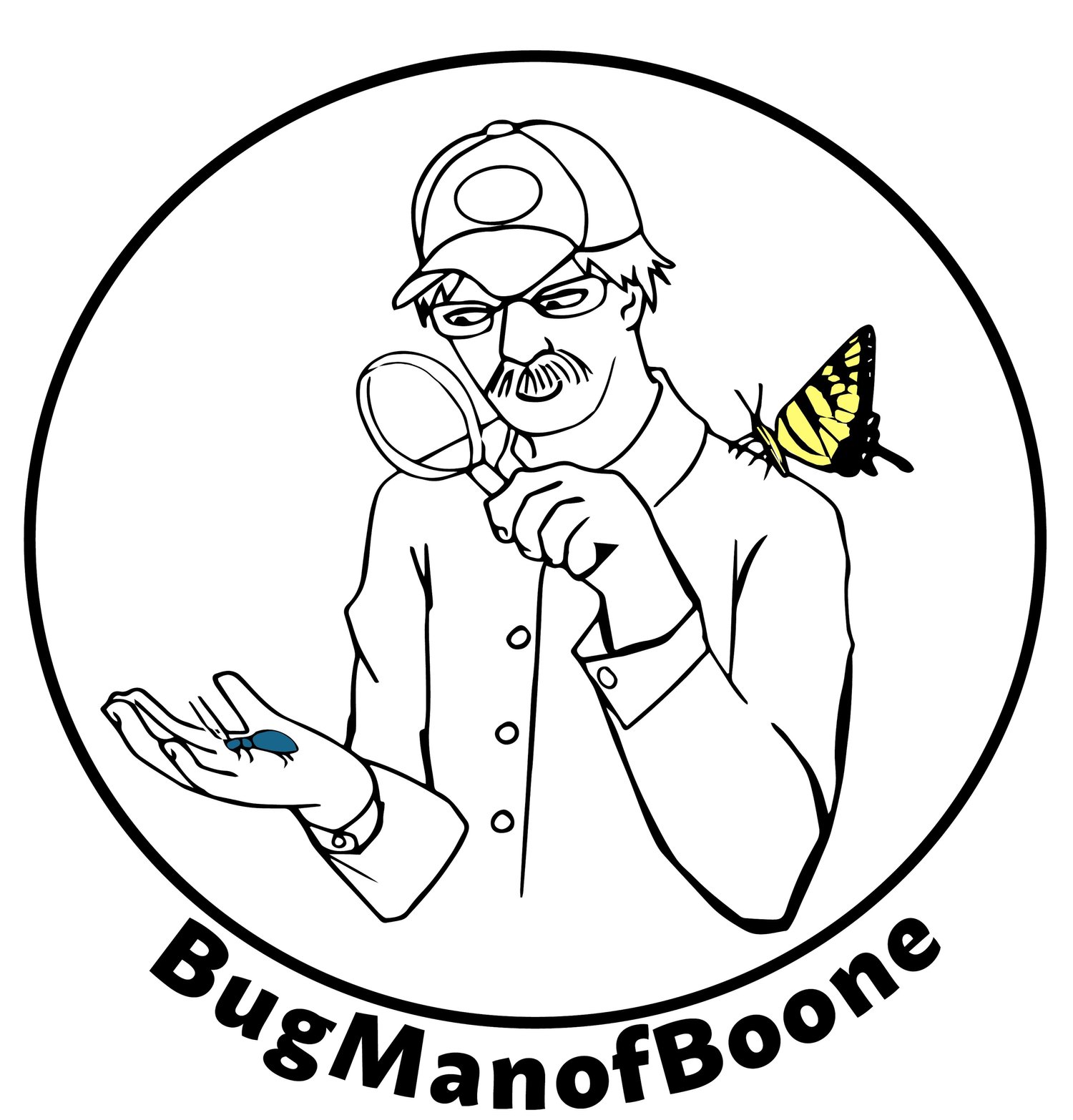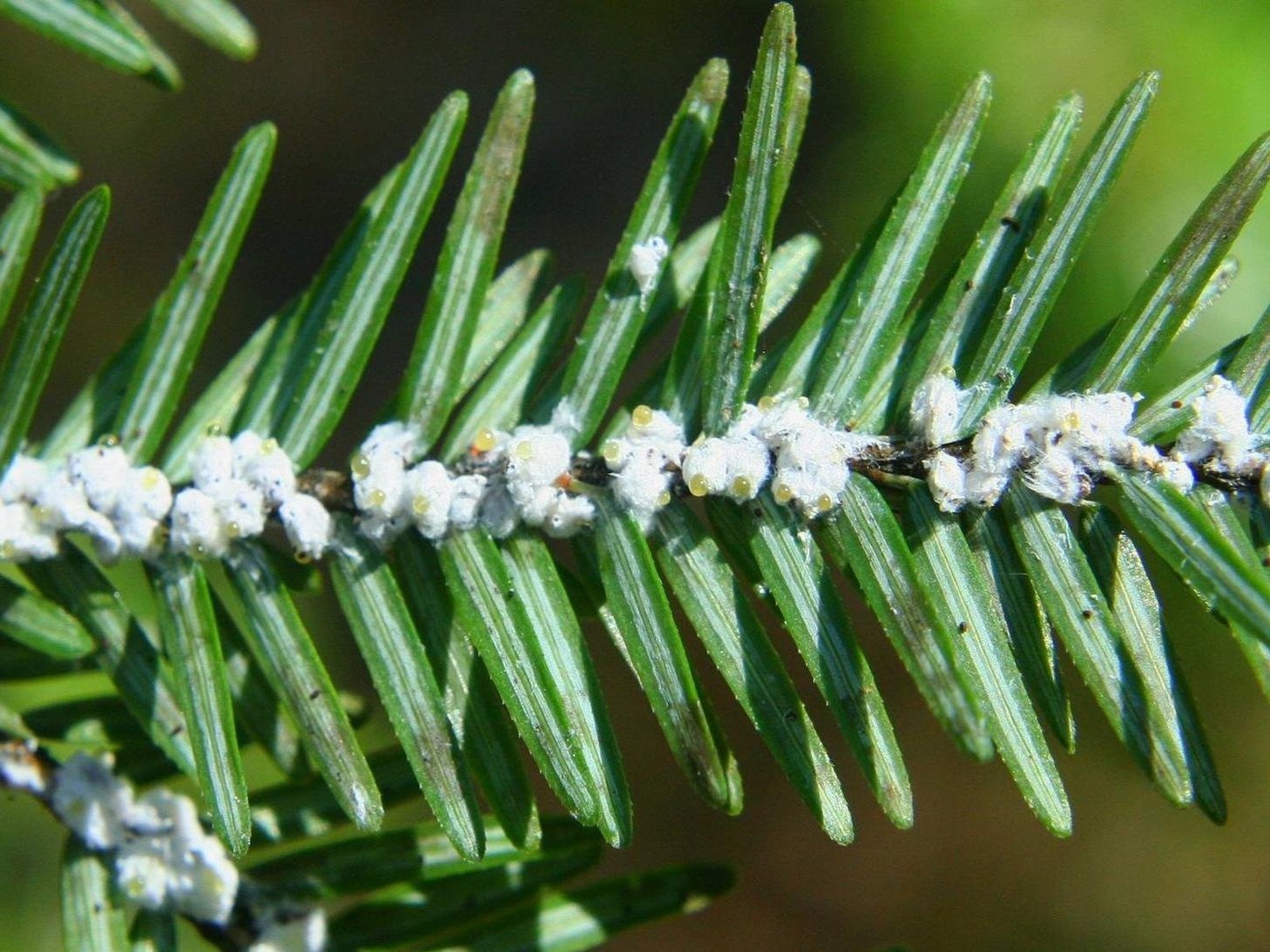Be on the lookout for bad bugs in the High Country
Though there are many interesting bugs in the High Country, not all are good for some of our plants. This is especially true for non-native (exotics) insects, which are sometimes referred to as invasive. Because many of our plants have few natural defenses against these invaders, such as predators that feed on the bugs, or parasites that kill them, the result in some cases is serious damage and death to native plants. While the non-native marmorated stink bugs and Asian lady beetles that may come into your house over winter are annoying, other invasive bugs in our area are much more concerning.
You may have already observed damage to (and often the ultimate death) many of our Carolina and Eastern (Canadian) hemlock caused by the hemlock woolly adelgid, Adelges tsugae. The many small white “blobs” on the tree branches where the needles attach in infested trees are in fact a covering for the bodies of this sap-sucking invasive insect. The adelgid originated from Asia (possibly Japan too) and was found in the U.S. Pacific Northwest many years ago. In the 1950s they were discovered in Virginia and have slowly spread throughout the Eastern U.S. They have an interesting life cycle, where females (there are no male adelgids!) lay eggs that hatch into wingless “crawlers” which move about the tree feeding on branches and eventually producing their white, waxy cover. Because females produce many eggs, the adelgid population can be enormous on an individual tree. To make matters worse, there is more than one generation produced per year.
Photo credit: Tom Coleman, USDA Forest Service, Bugwood.org
Chemicals may be used to protect individual trees, but this is not a practical or indeed safe solution for large numbers of trees. Even though few natural defenses by the hemlocks apparently exist for now, there is some good news for our hemlocks. Researchers are finding success rearing and releasing in large numbers small beetles that eat the adelgid, reducing their populations and in some cases resulting in tree recovery. If successful, over the long term the beetle-releasing biological control strategy could provide a way for our hemlocks to survive and thrive in the years to come.
Photo Credit: David Cappaert, Bugwood.org
The emerald ash borer, Agrilus planipennis, gets its name from the metallic green adult beetle. Though handsome in appearance, the bugs' effects on our native ash trees is devastating. A native of Asia, this wood boring insect first appeared in the upper midwestern US but has since rapidly spread. Unlike the sap-sucking hemlock woolly adelgid, the emerald ash borer feeds under the tree bark. Adults are found in spring feeding on the ash leaves and after mating the female lays eggs. The young (larvae) hatch and bore into the bark, where their feeding cuts off the food supply throughout the tree, eventually resulting in tree death.
Ray Williams
Distinctive “galleries” are carved into the wood by the munching insects. Larvae overwinter in the tree and in spring produce a pupa that develops into an adult. The adult beetles bore out of the tree leaving a visible hole, begin to eat and the cycle continues. Attacked trees may succumb in a few years (or sooner), leaving behind the tell-tale galleries in the wood as the bark peels away. There are few natural defenses against the emerald ash borer, although researchers are exploring releasing small wasps that lay eggs on and kill the insect. You may notice the next time you’re camping warning signs about not taking firewood from where you are into other areas. That’s because this ash borer can easily be transported to places it is not found through the wood. It is especially important to take these warnings seriously to prevent further spread of this damaging insect.
Though the hemlock woolly adelgid, and more recently the emerald ash borer, have become established unwelcome invasive insects, we need to be diligently watching for other concerning insects that may find our area home. This is especially true for the plant-sucking spotted lantern-fly, Lycorma delicatula. Also a native of Asia, this highly damaging insect threatens agricultural plants, including fruit trees, and especially grapes. Originally found in Pennsylvania, and established now in parts of nearby southern Virginia, the insect’s incidence in North Carolina just to our east is currently limited but likely to increase in the future. Fortunately reports of this serious pest in the High Country are not known at this time. The adult has black spots on grayish wings and is sometimes confused with some moths; you have to look closely to property identify it. The movement of this insect is not so much from adults flying but eggs being carried on vehicles, wood, transported structures, etc. Carefully inspecting belongings before leaving areas where the lantern fly exists is important. Good information on identifying this insect and reporting sightings may be found at https://content.ces.ncsu.edu/spotted-lanternfly
Photo Credit: Emelie Swackhamer, Penn State University, Bugwood.org
Though unwelcome, invasive insects are becoming part of our local insect communities through unfortunate introductions, and by the great capacity for bugs to move around. When spring arrives, watching out for the invasives presented in this article, and reporting incidents of new invaders, will assist in helping state and local agencies develop good policies to hopefully control their impacts.
References:
Steven Frank, James Baker, Stephen Bambara, Robert Baldwin. Hemlock Woolly Adelgid. NC State Extension Publication. 2019. https://content.ces.ncsu.edu
HemlockWoolly Adelgid. Virginia Polytechnic Institute. https://hiro.ento.vt.edu/hwa
Olivia Andrews. Virginia Cooperative Extension, Publications and Educational Resources. Hemlock Woolly Adelgid. 2022. https://www.pubs.ext.vt.edu/3006/3006-1451/3006-1451.html
Hemlock Restoration Imitative savehemlocksnc.org
Watauga Democrat, January 13, 2015.
https://www.wataugademocrat.com/news/hope-still-alive-for-hemlocks/article_814b3cd4-9b7d-11e4-bbc1-9b9106df95e2.html
Kelly Oten and Ryan Bohannon. NC State Extension Publication. Emerald Ash Borer. 2020. https://content.ces.ncsu.edu/emerald-ash-borer
Ryan Bohannon and Kelly Oten. NC State Extension Publication. Biological Control of Emerald Ash Borer in North Carolina. 2022. https://content.ces.ncsu.edu/biological-control-of-emerald-ash-borer-in-north-carolina
Kelly Oten. NC State Extension Publication. Spotted Lanternfly. 2021. https://content.ces.ncsu.edu/spotted-lanternfly
Portions of this article appeared in the Watauga Democrat (Boone, NC) on February 3, 2023
https://www.wataugademocrat.com/news/local/be-on-the-lookout-for-bad-bugs-in-the-high-country/article_16ad275a-9b3a-11ed-84b9-6b8b5d816695.html




